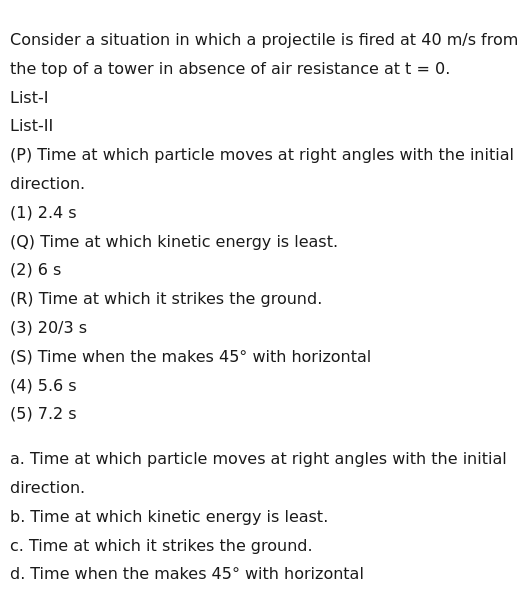Question
Question: Consider a situation in which a projectile is fired at 40 m/s from the top of a tower in absence of ...
Consider a situation in which a projectile is fired at 40 m/s from the top of a tower in absence of air resistance at t = 0. List-I List-II (P) Time at which particle moves at right angles with the initial direction. (1) 2.4 s (Q) Time at which kinetic energy is least. (2) 6 s (R) Time at which it strikes the ground. (3) 20/3 s (S) Time when the makes 45° with horizontal (4) 5.6 s (5) 7.2 s

Time at which particle moves at right angles with the initial direction.
Time at which kinetic energy is least.
Time at which it strikes the ground.
Time when the makes 45° with horizontal
P-3, Q-1, R-2, S-4
Solution
The problem describes projectile motion from the top of a tower with an initial speed of 40m/s at t=0. We assume the acceleration due to gravity is g=10m/s2. Let the initial velocity be v0 and the velocity at time t be v(t). We have v(t)=v0+gt. Let the initial velocity be v0=v0cosθi^+v0sinθj^, where v0=40m/s and θ is the angle with the horizontal. We take g=−gj^=−10j^.
(P) Time at which particle moves at right angles with the initial direction. The condition is v(t)⋅v0=0. (v0+gt)⋅v0=0⟹∣v0∣2+t(g⋅v0)=0. v02+t(∣g∣∣v0∣cosα)=0, where α is the angle between g and v0. v02+tgv0cosα=0⟹v0+tgcosα=0. t=−gcosαv0. For t>0, we need cosα<0, so 90∘<α≤180∘. The angle between v0=(v0cosθ,v0sinθ) and g=(0,−g) is given by v0⋅g=∣v0∣∣g∣cosα. −gv0sinθ=v0gcosα⟹cosα=−sinθ. The condition 90∘<α≤180∘ implies −1≤cosα<0, so 0<sinθ≤1. This means the initial velocity must have a positive vertical component, i.e., 0<θ≤90∘. The time is t=−g(−sinθ)v0=gsinθv0=10sinθ40=sinθ4. From the options in List-II, let's check which time t satisfies t=4/sinθ for some 0<θ≤90∘. This requires t≥4/1=4. (1) t=2.4: 2.4<4, not possible. (2) t=6: 6=4/sinθ⟹sinθ=4/6=2/3. Possible. (3) t=20/3≈6.67: 20/3=4/sinθ⟹sinθ=4/(20/3)=12/20=3/5. Possible. (4) t=5.6: 5.6=4/sinθ⟹sinθ=4/5.6=40/56=5/7. Possible. (5) t=7.2: 7.2=4/sinθ⟹sinθ=4/7.2=40/72=5/9. Possible. Multiple times are possible depending on the initial angle θ. This suggests that other conditions or items might help determine the specific scenario.
(Q) Time at which kinetic energy is least. Kinetic energy is KE=21m∣v(t)∣2. ∣v(t)∣2=(v0cosθ)2+(v0sinθ−gt)2. ∣v(t)∣2=v02cos2θ+v02sin2θ−2v0sinθgt+g2t2=v02−2v0sinθgt+g2t2. This is minimized when the vertical component of velocity is zero, which occurs at time t=gv0sinθ. This requires sinθ>0, i.e., the projectile is fired upwards. t=1040sinθ=4sinθ. Since 0<θ≤90∘, 0<sinθ≤1, so 0<t≤4. From the options in List-II, only t=2.4 satisfies 0<t≤4. If t=2.4, then 2.4=4sinθ⟹sinθ=2.4/4=0.6=3/5. This is possible for θ=arcsin(3/5)≈36.87∘. So, if the initial angle is θ=arcsin(3/5), the time of minimum KE is 2.4 s. This matches (Q) with (1). Let's assume this initial angle θ=arcsin(3/5). For this angle, sinθ=3/5 and cosθ=4/5. The time for (P) is t=sinθ4=3/54=320 s. So, (P) matches (3).
Let's verify the other items with this initial angle θ=arcsin(3/5) and v0=40, g=10. Initial velocity v0=40(4/5)i^+40(3/5)j^=32i^+24j^. Velocity at time t: v(t)=32i^+(24−10t)j^. Position at time t: r(t)=32ti^+(24t−5t2)j^. Let the height of the tower be H. The initial height is y(0)=0. The ground is at y=−H.
(R) Time at which it strikes the ground. The particle strikes the ground when y(t)=−H. 24t−5t2=−H⟹5t2−24t−H=0. The time t depends on the height H. Since the options for (R) are specific times, the height H must be such that one of these times is the positive root of this quadratic equation. Let's check the options for (R): (2) t=6: 5(62)−24(6)−H=0⟹5(36)−144−H=0⟹180−144−H=0⟹H=36. If the tower height is 36 m, the time to strike the ground is 6 s. This matches (R) with (2). Let's check if this height is consistent with other items. The problem statement does not give the height of the tower. The question asks to match the lists, implying a specific scenario is intended. The calculated matches (Q)-(1) and (P)-(3) depend only on the initial velocity and g. The match (R)-(2) implies a tower height of 36 m. This seems consistent.
(S) Time when the velocity vector makes 45° with the horizontal. The velocity vector is v(t)=32i^+(24−10t)j^. The angle ϕ the velocity vector makes with the horizontal is given by tanϕ=vx(t)vy(t)=3224−10t. We want the time when ∣ϕ∣=45∘, so tanϕ=±1. Case 1: tanϕ=1. 3224−10t=1⟹24−10t=32⟹10t=24−32=−8⟹t=−0.8 s. This is before the projectile is fired, so not a valid time. Case 2: tanϕ=−1. 3224−10t=−1⟹24−10t=−32⟹10t=24+32=56⟹t=5.6 s. This is a positive time. At t=5.6 s, vx=32 and vy=24−10(5.6)=24−56=−32. The velocity vector is 32i^−32j^, which makes an angle of −45∘ (or 45° below the horizontal) with the horizontal. This matches (S) with (4).
So, the proposed matches are: (P) - (3) : Time at which particle moves at right angles with the initial direction (20/3 s) (Q) - (1) : Time at which kinetic energy is least (2.4 s) (R) - (2) : Time at which it strikes the ground (6 s) (S) - (4) : Time when the velocity makes 45° with horizontal (5.6 s)
These matches are consistent with an initial launch angle θ=arcsin(3/5)≈36.87∘ upwards from the horizontal and a tower height of 36 m. Since all list items are matched uniquely to options from List-II, this is the intended scenario.
Final check of matches: P -> 3 (20/3 s) Q -> 1 (2.4 s) R -> 2 (6 s) S -> 4 (5.6 s)
Let's verify the remaining option in List-II, (5) 7.2 s. It is not matched with any item in List-I. This is acceptable as List-II has more options than List-I.
The set of correct matches is P-3, Q-1, R-2, S-4.
